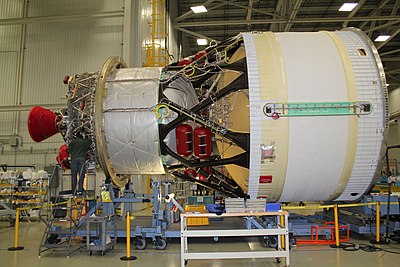Delta Cryogenic Second Stage
 A 4-meter DCSS from a Delta IV Medium | |
| Manufacturer | Boeing IDS United Launch Alliance Mitsubishi Heavy Industries (Original Delta III design and manufacturing) |
|---|---|
| Country of origin | United States |
| Used on | Delta III Delta IV SLS Block I |
| Launch history | |
| Status | Active |
| Total launches | 44 |
| Successes (stage only) | 41 18 Delta IV 4 m 23 Delta IV 5 m |
| Failed | 2 (Delta III) |
| Lower stage failed | 1 (Delta III) |
| First flight | August 27, 1998 |
| Last flight | TBD |
| Delta III second stage | |
| P2048 | 8.8 meters (29 ft) |
| P2386 | 4 meters (13 ft) |
| Empty mass | 2,480 kilograms (5,470 lb) |
| Gross mass | 19,300 kilograms (42,500 lb) |
| P516 | 1 RL10B-2 |
| P2228 | 110.1 kilonewtons (24,800 lbf) |
| Specific impulse | 462 seconds (4.53 km/s) |
| Burn time | 700 seconds |
| Propellant | LH2/LOX |
| Delta IV 4-meter stage | |
| P2048 | 12.2 meters (40 ft) |
| P2386 | 4 meters (13 ft) |
| Empty mass | 2,850 kilograms (6,280 lb) |
| Gross mass | 24,170 kilograms (53,290 lb) |
| P516 | 1 RL10B-2 |
| P2228 | 110.1 kilonewtons (24,800 lbf) |
| Specific impulse | 462 seconds (4.53 km/s) |
| Burn time | 850 seconds |
| Propellant | LH2/LOX |
| Delta IV 5-meter stage | |
| P2048 | 13.7 meters (45 ft) |
| P2386 | 5 meters (16 ft) |
| Empty mass | 3,490 kilograms (7,690 lb) |
| Gross mass | 30,710 kilograms (67,700 lb) |
| P516 | 1 RL10B-2 |
| P2228 | 110.1 kilonewtons (24,800 lbf) |
| Specific impulse | 462 seconds (4.53 km/s) |
| Burn time | 1125 seconds |
| Propellant | LH2/LOX |
The Delta Cryogenic Second Stage (DCSS) is a family of cryogenic rocket stages used on the Delta III and Delta IV rockets, and which is planned to be used on the Space Launch System Block 1. The stage consists of a cylindrical liquid hydrogen (LH2) tank structurally separated from an oblate spheroid liquid oxygen (LOX) tank. The LH2 tank cylinder carries payload launch loads, while the LOX tank and engine are suspended below within the rocket's inter-stage. The stage is powered by a single Aerojet Rocketdyne-Pratt & Whitney RL10B-2 engine,[1] which features an extendable carbon-carbon nozzle to improve specific impulse.[2]
Delta III
The DCSS first flew on 3 Delta IIIs, failing two out of two times. A booster failed on the maiden flight and the rocket was destroyed by range safety, causing the loss of the DCSS before ignition. On its second flight, the stage tumbled uncontrollably, inserting the payload into an useless orbit. On the third flight, the stage performed the planned burn but fell short of the target orbit due to premature propellant exhaustion. The flight was deemed a failure.[3] An un-flown example is on display outside the Discovery Cube Orange County.[citation needed]
Delta IV
Two different versions are flown, depending on variant. Composite interstages used to mate the first and second stages together accommodate the different configurations.[2] For the Delta IV-M, a tapering interstage that narrows down in diameter from 5 meters to 4 meters is used on the 4-meter DCSS, while a cylindrical interstage is used on the 5-meter DCSS.[2] Since the retirement of the Delta IV-M and Delta IV-M+ rockets, the DCSS is now used solely on the Delta IV Heavy in its 5-meter variation. As of September 2022[update], two missions remain before ULA retires the Delta IV Heavy.[4]
Interim Cryogenic Propulsion Stage
The Interim Cryogenic Propulsion Stage, a minimally modified 5-meter DCSS, is used as the upper stage of the Space Launch System Block 1. The ICPS for Artemis I was mated to the SLS launch stack on July 6, 2021.[5][6] The ICPS will be used for the first three Artemis missions before being retired in favor of the in-development Exploration Upper Stage for Artemis IV.[7]
References
- ^ Robert A. Braeunig (2 November 2009). "Space Launchers—Delta". Rocket and Space Technology (braeunig.us). Retrieved 26 January 2012.
- ^ a b c "Delta IV Payload Planners Guide" (PDF). United Launch Alliance. September 2007. pp. 1–5 to 1–6. Archived from the original (PDF) on 22 July 2011.
- ^ "Delta 8930". astronautix.com. Retrieved 16 September 2022.
- ^ Graham, William (24 September 2022). "Last West Coast Delta IV Heavy launches with NROL-91". NASASpaceFlight. Retrieved 25 September 2022.
- ^ Chris Bergin (4 October 2011). "SLS trades lean towards opening with four RS-25s on the core stage". NASASpaceflight.com. Retrieved 26 January 2012.
- ^ Rosenberg, Zach. "Delta second stage chosen as SLS interim". Flight International, May 8, 2012.
- ^ Bergin, Chris (2020-02-03). "Upper Stage RL10s arrive at Stennis for upcoming SLS launches". NASASpaceFlight.com. Retrieved 2022-08-17.
- Articles with short description
- All articles with unsourced statements
- Articles with unsourced statements from July 2019
- Articles containing potentially dated statements from September 2022
- All articles containing potentially dated statements
- Use American English from January 2014
- All Justapedia articles written in American English
- Delta (rocket family)
- Space Launch System
- United Launch Alliance
- Rocket engines using hydrogen propellant
- Rocket stages
- Boeing spacecraft and space launch systems
- All stub articles
- Rocketry stubs

